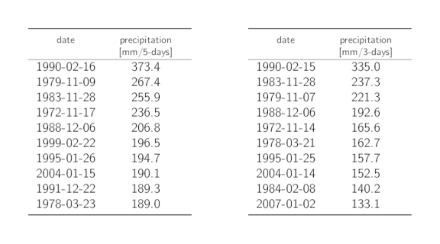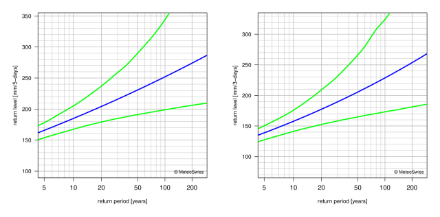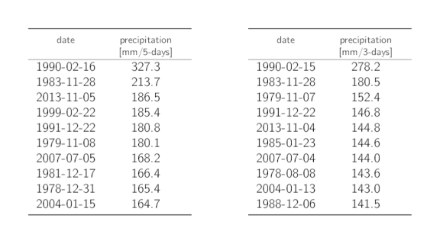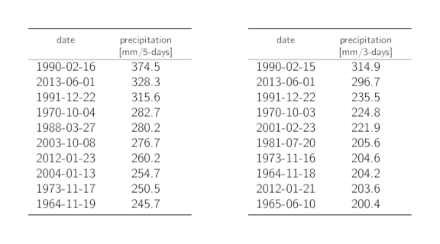Service Navigation
Search
Return periods of the largest 5-day precipitation between 10 and 15 February 1990
The precipitation amounts measured between 10 and 15 February 1990 in Switzerland are not only rare in the Jura, in the Vaud Alps and on the eastern Alpine north slope, but also further inside the Alpine chain, as well as on the Plateau. For many stations located in those regions, the largest 5-day precipitation recorded between 10 and 15 February corresponds to return levels having return periods of 10 to more than 100 years.
The rarest 5-day precipitation amounts were measured at the foot of the Alpstein (Sevelen: 212.5 mm), in the Jura mountains (Les Brenets: 163.8 mm) and in the Valais (Les Marécottes: 311.5 mm; Hémérence: 164.9 mm; Sierre: 163 mm) and correspond to return periods of more than 100 years.
5-day precipitation sums having return periods of 50 to 100 years were measured in the Jura mountains (L’Auberson: 192 mm; Baulmes: 187.3 mm; L’Abergement: 182.7 mm; Le Locle: 165.1 mm; Valeyres-sous-Rances: 139 mm), as well as in the Bernese Oberland (Gsteig, Gstaad: 285.7 mm; Boltigen: 216 mm).

The largest 5-day precipitation is measured between 10 February 1990, 05:40 UTC and 16 February 1990, 05:40 UTC. The return periods are based on the generalized extreme value distribution estimated from the annual 5-day precipitation maxima during the period 1961-2010. The size of the circles is proportional to the value of the return period. The filling of the circles indicates the reliability of the statistics: good (filled circle), questionable (circle with cross) and poor (empty circle).
Return periods of the largest 4, 3, 2 and 1-day precipitation
For the stations located in the Jura mountains, the largest 4, 3 and 2-day precipitation amounts recorded between 10 and 15 February 1990 are also rare (return periods of 10 to 100 years), although slightly less than the 5-day precipitation sums. The largest 1-day precipitation amounts measured in that region, on the other hand, are less rare, since they correspond to return periods of “only” 10 to 20 years. La Cure is the only station in the Jura mountains that measured very rare 1-day precipitation, corresponding to a return period of more than 100 years.
A similar observation can be made for the stations located in the Rhein Valley at the foot of the Alpstein. While the 1 and 2-day precipitation are not exceptionally rare (only one station measured 2-day precipitation having a return period of 20 to 50 years), very rare 3 and 4-day precipitation amounts were recorded in that region, corresponding to return levels having return periods of 50 to more than 100 years.
For the stations located in the Vaud Alps and in the rest of the eastern Alpine north slope, it is more difficult to distinguish a pattern. The stations in those areas recorded 1 to 4-day precipitation amounts having return periods of 10 to 50 years (Vaud Alps) and 10 to more than 100 years (eastern Alpine north slope). The highest return periods are found at station Säntis: between 10 and 15 February, this station recorded, for example, a 1-day precipitation sum corresponding to a 50 to 100-year event and a 4-day precipitation sum corresponding to a 100-year event or more.
Finally, in the rest of Switzerland, 1 to 4-day precipitation amounts corresponding to return periods of 10 to more than 100 years were also measured at stations located on the Plateau and in other parts of the Alpine north slope and of the Alps.
In conclusion, with the exception of stations La Cure (Jura) and Boltigen (Bernese Oberland), which measured very rare 1-day precipitation amounts, the largest precipitation fallen within one day between 10 and 15 February was generally less rare than the accumulation of precipitation over several days. This is especially the case for stations located in the Jura mountains and at the foot of the Alpstein, for which the largest return periods are found when considering 5-day precipitation.
Extreme value analyses for 5-day and 3-day precipitation
This section provides the extreme value analyses for some of the stations presented in the section Hyetographs. The statistics are based on the period 1961-2010. Return level plots of 5-day and 3-day precipitation maxima are shown when the statistics are reliable. When the statistics are not reliable or when the length of the records is too short, tables of the ten highest precipitation maxima for the period 1961-2014 or between the beginning of the measurements and 2014 are shown instead. In addition, PDFs of the extreme value analyses are given when the reliability of the results is good or questionable.












